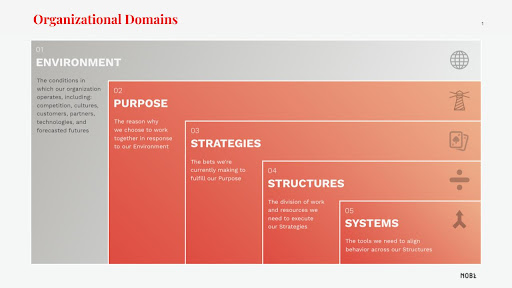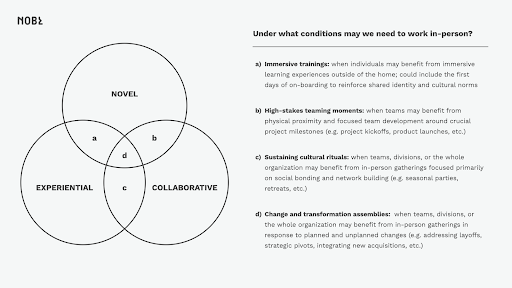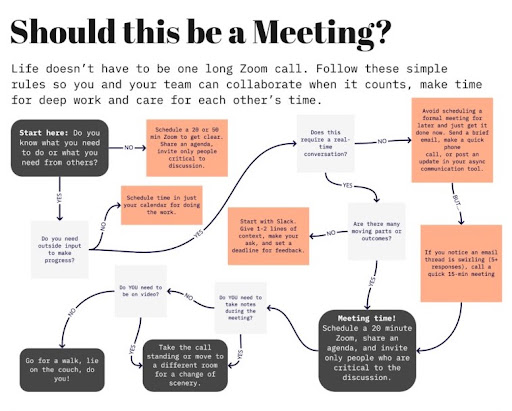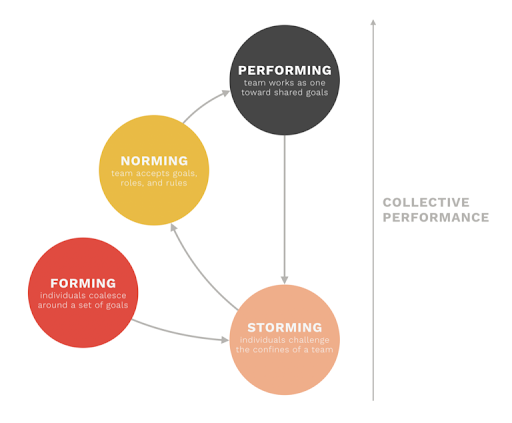Leaders are understandably concerned about the impact of remote work and hybrid work on company culture: how will new employees learn established ways of working if they’re not sitting next to each other? How can you foster loose ties between employees if they’re no longer running into each other in the office? And how can you encourage better work life balance when remote workers in different time zones are “always on”?
At the same time, many employees who experienced remote work over the course of the pandemic want to maintain their remote flexibility and autonomy—and given the competitive job market, they can often find other companies who’ll offer it. How, then, should management retain and attract top talent when considering the return to the office?
The good news is that “remote work” and “healthy company culture” can successfully co-exist. In fact, this is a transformative moment: managers have a unique opportunity to re-evaluate flexible work, and create a working environment that works, regardless of where employees are located. Rather than leaving it to individual employees to figure it out on their own, though, organizations must be intentional about their culture, and set up systems and technology that support the ways teams work together.

NOBL has helped world-famous organizations respond to the new normal of work by leveraging the best of both what the physical office and digital tools can offer teams and cultures. Reach out to see how we might be able to help your organization.
What Is Company Culture?
Before we talk about remote work culture, though, let’s start with the basics: what exactly do we mean by “company culture”? We define culture as an emergent property of interpersonal interaction, mediated by the organization’s environment, purpose, strategies, structures, and systems. Let’s break that down:
Culture is an emergent property: Cultures are organic. They emerge. But they can also be formed intentionally. People can and should be thoughtful, purposeful, and responsible around the behaviors, values, attitudes, beliefs, and assumptions they share. This means people can be empowered to design the culture they want, but they have to view culture holistically.
Furthermore, companies can have sub-cultures that represent different values, beliefs, and norms. In our opinion, this diversity is important and necessary—your legal team should behave differently than, say, a creative discipline. The crucial thing is to foster positive interaction and collaboration across these cultures.
Of interpersonal interaction: Culture is foremost produced by how your employees interact with one another. Of course, how they interact is influenced by everything from societal norms to corporate policies (implicit or explicit).
Mediated by the organization’s environment, purpose, strategies, structures, and systems: Organizations have four domains that you can impact:
- Purpose: what draws employees to your organization
- Strategies: what trade-offs they make in decision making
- Structures: how they are organized
- Systems: the internal norms, processes, technology, and tools they use to get their work done

Our bias, after years of study and practice, is that the biggest leverage points for culture change lie in the domain of Systems, which includes activities like how you hire, onboard, promote, share information, meet, give feedback, and make decisions. These are powerful levers not only because they affect everyone, but because you can experiment with changes quickly and safely, and see results sooner than, for example, a costly restructure.
How This Applies to Remote Work
You may have noticed that nothing about the above definition is specific to an office or remote work. Especially at the Systems level, activities can and should be adapted to suit the needs of each workplace, wherever that may be. Companies can absolutely design a remote work culture that’s just as vibrant, productive, and healthy as one in the office. But how?
Designing Culture for Remote Work, Office Work, and Everything in Between
A closer look at the “Systems” domain—again, the meetings, decision-making processes, tools, and norms that employees adopt to get things done—shows that employees typically struggle with certain types of work and skill sets required for remote work. In particular, activities requiring creativity or collaboration (or put another way, debates and disagreements) are the most challenging for remote working. Without the tech or norms for holding these discussions, remote workers tend to avoid them, even if they’re necessary for carrying the work forward. Other aspects of the business, however, can be produced just as effectively while remote working, and in fact allow for greater focus and concentration.
That’s why savvy managers should let the type of work dictate where and how employees work, rather than implementing policies based on personal preferences or an arbitrary schedule. Furthermore, instead of creating an equal environment—like by mandating that all employees return to the office—management should strive to create an equitable environment, in which adjustments are made depending on where and how employees work. One of the simplest ways to think through these challenges is applying a variation on the classic Employee Experience Map.
Employee Experience Mapping: Designing for the Workforce, Regardless of Location

Our variation accounts for three potential tracks—full time office based work, full time remote work, and hybrid—so you can better create a more equitable workplace, wherever that may be. Here’s how we’d suggest using it:
- First, identify key touchpoints in which the employee engages with your company. This could begin as soon as their first interaction with your company—perhaps by using your product, or during a meeting at a recruiting event—and lasts until their last day on the job and beyond, if you have an alumni network. We’ve listed the most common touchpoints to get you started, but your company may have its own milestones.
- Next, think through this experience for each type of employee: in office, working remotely, and hybrid. What’s working well for them? What’s not working so well? We’ve included some questions to get you started. If you find yourself struggling to identify the pluses and minuses, though, turn to the source: invite employees to a retro to build out these experiences. Regular engagement surveys can also be excellent sources of information; just make sure you’re also identifying whether they are in office, work remotely, or hybrid, so you have a better understanding of what’s working, where.
- Assess what types of work must take place in-person, and what can be accomplished through remote work. We need to start thinking of the office as just another tool we use to get work done, one that should only be selected when it makes sense given the activities required. Coming into a physical location (whether that’s an office, a coworking space, or offsite location) may still have benefits when work is a combination of two or more of the following conditions:
- Novel: the task or challenge is new; there may not be an established process
- Experiential: an immersive experience can possibly be more effective
- Collaborative: when tasks require sustained synchronous participation among a group.

- Mind the gaps. Now that you’ve mapped out the experience, look for the gaps: what are the biggest differences in how employees work? For instance, your remote employees may need to attend more in-person conferences, while your office based employees may need flex hours to pick up their kids from school. Remember, your goal is to make things more equitable by addressing unique concerns, not to implement the same solution for everyone. We’ve identified the touchpoints that typically have the largest gaps in red.
- Then, explore the common pain points employees are now experiencing. Are there any areas where all employees are struggling? Are some touchpoints more critical than others when it comes to attracting and retaining employees? Some of the more important pain points we’ve heard across the board include meeting fatigue, missed connections, work-life balance, and office politics.

- Pick one or two things to prioritize. People are already experiencing epic levels of burnout; trying to change too many things at once will only lead to more frustration. Look for quick wins that will demonstrate your commitment to solving these challenges, and if possible, deprioritize other work until some fixes can be implemented.
Rebuilding Interpersonal Interaction When You Can’t Be in Person
While adapting systems are helpful to building a better company culture, they’re not enough. Returning to our definition of culture, we see that’s it’s an emergent property of interpersonal interaction. Managers these days face a rather unusual situation, in that employees are often expected to develop working relationships with people they’ve never met in person. Onboarding, celebrations, and collaboration are tricky enough done virtually, though it’s possible to compensate. What’s really challenging are those tense, but critical, moments in a team’s existence, like disagreement, tough feedback, or difficult conversations around structural issues.
According to psychologist Bruce Tuckman, this is “storming”—one of the four stages teams go through on their way to becoming high-performing teams. It’s when teams uncover tensions and working styles start to clash. While some fall apart at this stage, if you successfully navigate it, it builds real trust and defines how the team will work together.

Storming isn’t exactly easy in person. But it is easy to misread tone from Slack or email messages, and hard to read body language and nuance on Zoom (especially because facial expressions are more ambiguous than you think). That’s if you’re watching the other person at all—we’re easily distracted by watching ourselves on Zoom. And it’s not just your conscious reading of body language and non-verbal communication; it’s energetic—you literally get “in sync” with someone when you’re in person with them. So how can remote employees compensate, and quickly move into “norming” and “performing”?
The Role of Psychological Safety in Remote Work
The most important element of interpersonal interaction is psychological safety: that is, employees feel comfortable discussing potentially controversial issues. Sharing bad news or a new idea is difficult, so you must deliberately foster a climate in which people can speak freely, without fear of retribution.
Project Aristotle, a multi-year research project into the highest-performing teams at Google, identified five key ways managers can foster psychological safety:
- Demonstrate engagement. When interacting with employees, be present, asking questions about the matter at hand. Don’t get distracted by gadgets or emails.
- Show understanding. Validate comments and recap what others have said. That doesn’t mean you have to agree with everything, just that you acknowledge their point of view.
- Be inclusive in interpersonal settings. Show interest in your employees as people, not just “resources.” Ask about their non-work lives, and schedule 1:1s to discuss what new skill sets they want to develop in their careers.
- Be inclusive in decision-making. Get input from employees before making a decision, and explain the thought process behind the final decision.
- Show confidence while being flexible. Take personal risks and encourage employees to question your opinions, while giving them credit when meeting with senior management.
Again, many of these recommendation make sense whether you’re work in the same office or work from home, but a significant amount rely on in-person cues like eye contact or body language, which is far more challenging to see on Zoom. Other suggestions, like holding regular feedback sessions and expressing gratitude, require more effort, as opposed to dropping by a colleague’s desk.
How Other Companies Make Remote Jobs Work
With more remote employees, managers must quickly adapt to virtually fostering psychological safety. We analyzed some of the best-known distributed teams and found several principles that increase your odds of success:
- Hire employees who are capable of remote working. It might seem obvious, but make sure that you’re hiring people who don’t need an office. Zapier has found the best remote workers are action-oriented, comfortable without the social network an office provides, and good at written communication. Then, once you’ve hired people who you trust to do the work, let them do the work—don’t virtually hover over them.
- Model desired behavior from the beginning. Share your work style and vulnerabilities during the interview and onboarding process. The first time something goes wrong, frame it as an opportunity to learn rather than a blame-fest. And if someone does start to bad-mouth a colleague, cut off the discussion and redirect it to the issue at hand.
- Use the buddy system. To start building relationships between remote employees, rotate people through informal online chats with each other. (This is especially important when a new person joins a remote team: they won’t know the ropes, and may feel more comfortable asking a colleague than the boss.) According to Robin Dreeke, lead instructor of the FBI’s Counterintelligence Training Center, you can make these chats less stressful by limiting them to 15 minutes and encouraging people to listen to the other person’s story, asking simple questions like “how” and “why” to get them to open up.
- Develop a technology toolbox. Remote companies like Automattic (the web development company behind WordPress), Buffer, and Zapier each experimented with a variety of tools before landing on their preferred systems. While yours may vary, consider:
- Slack, Hipchat, or another messenger app. A “virtual watercooler,” these chat apps are great for including people in conversations and building a real sense of culture.
- Google Docs, P2, or another system of record. For important information, weekly ship updates, or documents that are frequently referenced, designate a central location for quick reference. Automattic uses WordPress theme P2 for discussions; Harvest has an internal blog called “Harvest Academy;” Zapier uses a blog modeled after P2 called Async. If you don’t want to complicate things, you could even use Google Form or Doc that’s easy to input.
- Google HangOuts, Skype, or other video chat program. Hold meetings with video so you can monitor visual cues, but be aware of your own body language—are you grimacing when a new idea is introduced, or nodding along in understanding?
- Set up regular 1:1s. Just as you would in a regular office setting, make sure you have a dedicated time to check in with your employees individually. Project management software Redbooth prefers to use Google Hangouts; again, visual cues help avoid communication errors. Use the time to discuss progress on projects as well as career development goals.
- Be more direct. Even with the best communication habits, remote employees are more likely to struggle to connect. When an email or text seems rude, assume Hanlon’s razor—it’s a miscommunication, rather than a deliberate effort to be rude. Emojis and GIFs can also be very helpful in conveying emotion. Lastly, you should be more upfront about what you need or the behavior you want to see, whether that’s praise or a request for distraction-free work time.
- Bring everyone together for an offsite at least once a year. No matter how good your tech and processes are, nothing beats getting people together in the same room. Retreats or offsites, lasting anywhere from a few days to over a week, are a combination of work and play, allowing workers to tackle larger projects. Buffer, for instance, uses their offsites to reinforce values like staying open-minded, as well as telling stories about the company’s origin and its future.
What Makes a Good Remote Culture?
Now that leaders know employees can work from home and maintain, and in fact, improve, productivity, more companies will be open to alternative and flexible work arrangements. But old habits die hard, and executives whose entire professional lives took place within the office may have the most difficult time adjusting. To create a positive working environment for the most workers, you must seriously and intentionally assess your culture, and decide how your organization should evolve.
Ultimately, there is no “best” or “right” remote work or office based culture—every company must determine what ways of working are best suited for their employees and market strategy. Nor should you expect all the issues that come with remote work be resolved overnight; realistically, it will take years of experimenting for many companies to determine the new “standard” for remote work.
The good news is that by this point, most employers have at least started experimenting with some variation on remote work policies. The easiest way to begin is with a remote work retrospective. Bring representatives from across the organization together to discuss what’s worked well about flexible work and remote work policies over the past six months, and what employees want to try doing differently. This can become a “first draft” of your organization’s remote work playbook, which you can then build and iterate on over time.
Sign up for our weekly newsletter to get more insights into leading transformation in your organization.








The Evolutionary Edge
Every Link Ever from Our Newsletter
Why Self-Organizing is So Hard
Welcome to the Era of the Empowered Employee
The Power of “What If?” and “Why Not?”
An Adaptive Approach to the Strategic Planning Process
Why Culture/Market Fit Is More Important than Product/Market Fit
Group Decision Making Model: How to Make Better Decisions as a Team